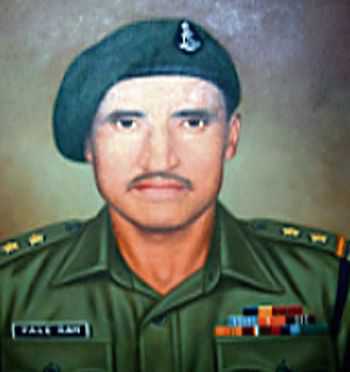Col Dilbag Dabas (Retd)
Men from Dabodha Kalan, Mandothi and Bhadani villages in present-day Jhajjar district traditionally chose the Army as a career and they still do so with pride as a duty to the nation. And all three villages can rightfully boast of having produced gallantry award winners: Lt Gen KK Singh, Maha Vir Chakra awardee, was from Bhadani village; Subedar Khazan Singh, Vir Chakra awardee, was from Mandothi; and Subedar Pale Ram, Vir Chakra awardee, was a resident of Dabodha Kalan village. These villages have also sent the highest number of ‘Sowars’ to Jat Horse Yeomanry raised in 1857. The first All Jat Horse Yeomanry (Cavalry Regiment) was later on designated as 14th Murray’s Jat Lancers (present day 20 Lancers) in 1903.
Pale Ram, son of Bhajan Singh, was born at Dabodha Kalan village on May 20, 1922. Following into the footsteps of his father, he too joined the Army. Since there was no school in his village, whatever he learnt was during his service with 3rd Battalion of Jat Regiment in which he was enlisted on May 20, 1940.
During the 1965 war with Pakistan in the western theatre, the iconic ‘Battle of Dograi’ was the one fought and won by the brave Jats of 3rd Battalion, first with guns and grenades, then with bayonets and finally with bare hands on the dark night of September 21/22, 1965. For its gallant action, 3 Jat Battalion was awarded three Maha Vir Chakras (including to its Commanding Officer Lt Col Desmond Hayde), four Vir Chakras, seven Sena Medals, 12 Mentioned-in-Dispatch and 11 COAS Commendation Cards — the highest tally for any Battalion/ Regiment of the Indian Army in a single battle before or since the Battle Honour ‘Dograi’.
Dograi is a small town across the border on the Amritsar-Lahore road and a gateway to Lahore, just 13 km north-east of it. It was also a vital ground for the Pakistan army to defend to obviate a free run by the Indian Army onto Lahore. Based on inputs received from various intelligence sources and through physical patrolling, it was believed that the main Pakistani defences with concrete bunkers and pill boxes along the Ichhogil canal and Dograi town were also supported by enemy tanks along the Pul distributary astride Upper Bari Doab Canal on the flanks. As per 54 Infantry Brigade operational orders, 3 Jat Battalion was to attack Dograi at midnight on September 21, 1965. A brief account of Subedar Pale Ram’s gallantry is available in the War Dairy of 3 Jat Battalion.
Subedar Pale Ram was also a Military Medal awardee during World War II and a veteran of the first war with Pakistan in Jammu and Kashmir in 1947-48. During the first battle of Dograi on September 6, 1965, he was totally exposed to the enemy automatic fire but he fearlessly aimed and fired a rocket launcher at the enemy's tanks, destroying one of them and slowing down the charge by the rest.
Subedar Pale Ram, twice awarded for gallantry with a Vir Chakra and a Military Medal, retired from the Army at the well-deserved honorary rank of Captain.
A Military Medal, roughly equivalent to present day’s Sena Medal (gallantry), was awarded to Junior Commissioned Officers and ranks below of the British Indian Army for their bravery during World War 1 and II.
The account of his gallantry in War Diary of 3 Jat Battalion reads
During the attack on Dograi, Subedar Pale Ram was the platoon commander of the reserve platoon with ‘C’ company. When ‘C’ and ‘D’ companies were engaged in a hand-to-hand fight in enemy bunkers, the reserve platoon headed by Subedar Pale Ram was ordered to capture the actual company objective. Subedar Pale Ram led the attack under heavy fire from light machine guns from left and right flanks. He himself crawled up to one machine gun bunker and silenced the gun by lobbing a hand grenade. Though seriously wounded, with disregard to his own safety he made his way to another machine gun bunker and destroyed it by courageously lobbing another hand grenade inside. Motivated by the exceptional courage and determination of Subedar Pale Ram, his platoon fought valiantly and captured the objective by the first light of September 22, 1965. Subedar Pale Ram received seven bullet wounds during the fight but refused evacuation till the mopping up of the defenses from bunker-to-bunker was carried out and the National Flag hoisted atop the highest bunker. For his indomitable courage and exceptional bravery in the face of the enemy, Subedar Pale Ram was awarded the Vir Chakra.
(The writer is a veteran Gunner, 6 Field Regiment)
Unlock Exclusive Insights with The Tribune Premium
Take your experience further with Premium access.
Thought-provoking Opinions, Expert Analysis, In-depth Insights and other Member Only Benefits
Already a Member? Sign In Now










